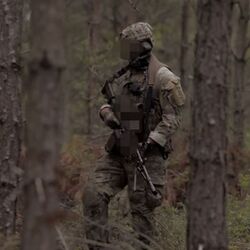Special Operations Task Group: Difference between revisions
No edit summary |
No edit summary |
||
| (5 intermediate revisions by the same user not shown) | |||
| Line 12: | Line 12: | ||
|garrison = Joint Forces Base Stennungsund, Götland, Acrea | |garrison = Joint Forces Base Stennungsund, Götland, Acrea | ||
|garrison_label = Headquarters | |garrison_label = Headquarters | ||
|motto = '' | |motto = ''“Uansett hva som trengs.”'' <br> "Whatever it takes." | ||
|colors = | |colors = | ||
|colors_label = | |colors_label = | ||
| Line 29: | Line 29: | ||
The '''Special Operations Task Group''' (Acrean: ''Spesielloperasjonsgruppe'', abbreviated '''SOG''') is a {{wp|Special forces|special operations}} force of the [[Acrean Armed Forces]]. It was first founded in 1942 as a deep reconnaissance and covert direct action unit. The unit performs a variety of missions, including special reconnaissance, counter-terrorism, direct action, hostage rescue, foreign internal defence, unconventional warfare, and raiding. Originally organised under the Army, the unit was combined with amphibious raiding units of the RAMC in 1955 to constitute a joint special operations unit. | The '''Special Operations Task Group''' (Acrean: ''Spesielloperasjonsgruppe'', abbreviated '''SOG''') is a {{wp|Special forces|special operations}} force of the [[Acrean Armed Forces]]. It was first founded in 1942 as a deep reconnaissance and covert direct action unit. The unit performs a variety of missions, including special reconnaissance, counter-terrorism, direct action, hostage rescue, foreign internal defence, unconventional warfare, and raiding. Originally organised under the Army, the unit was combined with amphibious raiding units of the RAMC in 1955 to constitute a joint special operations unit. | ||
== | ==Organisation and Training== | ||
[[File:SOGZemplen1.jpeg|thumb|left|250px|A SOG operator photographed in Ruvelka in 2009.]] | |||
SOG is organised into different groups comprising various capabilities. The core of the regiment are Special Operations Task Group 1, Special Operations Task Group 2, and Special Operations Task Group 3, which form the vast bulk of the regiment's operational strength. SOG-2 and SOG-3 are primarily responsible for Eracuran and Sidurian operations respectively, while SOG-1 has no primary geographic area of responsibility. | |||
In addition to the direct action groups, SOG also has Special Operations Task Group 4 and Special Operations Task Group 5. SOG-4 is responsible for intelligence and related affairs, while SOG-5 serves as the regiment's organic engineering and development wing. In this role, SOG-5 both provides technical and engineering expertise to direct action teams, and is also responsible for training the teams on new technology and equipment and overseeing their employment. | |||
SOG both directly recruits from both the Army and RAMC and accepts applications from prospective recruits. Prospective candidates for the direct action groups must undergo a two-phase process before they can begin selection and training; the first phase is a screening which determines initial eligibility and fitness for service in the unit, while the second consists of an 8 week long intensive school which aims to physically and mentally prepare prospective candidates for SOG training and selection. Once prospects have passed screening, they then begin training which consists of 28 weeks of fundamentals training which includes physical conditioning, land warfare, coastal warfare, and airborne training followed by an additional 28 weeks of advanced skills training at the Special Warfare School in Stennungsund. From here, SOG troopers further conduct specialised training in a given role, which can range from intelligence specialties like interpreters to combat specialties such as snipers. Today, SOG recruits both men and women in all roles. Intelligence and non-combat roles in SOG-4 and SOG-5 have been open to women since the 1990s, however combat roles in the direct action groups were first opened in 2010. The Special Warfare School reported its first female graduates in 2016. | |||
[[Category:Acrea]] | [[Category:Acrea]] | ||
[[Category:MT]] | [[Category:MT]] | ||
Latest revision as of 05:09, 24 September 2023
| Special Operations Task Group | |
|---|---|
 The Skull and Dagger flag adopted by SOG in 1942 | |
| Active | 26 March 1942 - Present (82 years, 8 months) |
| Country | |
| Type | Special forces |
| Size | Classified |
| Part of | Royal Acrean Army Royal Acrean Marine Corps |
| Headquarters | Joint Forces Base Stennungsund, Götland, Acrea |
| Motto(s) | “Uansett hva som trengs.” "Whatever it takes." |
The Special Operations Task Group (Acrean: Spesielloperasjonsgruppe, abbreviated SOG) is a special operations force of the Acrean Armed Forces. It was first founded in 1942 as a deep reconnaissance and covert direct action unit. The unit performs a variety of missions, including special reconnaissance, counter-terrorism, direct action, hostage rescue, foreign internal defence, unconventional warfare, and raiding. Originally organised under the Army, the unit was combined with amphibious raiding units of the RAMC in 1955 to constitute a joint special operations unit.
Organisation and Training
SOG is organised into different groups comprising various capabilities. The core of the regiment are Special Operations Task Group 1, Special Operations Task Group 2, and Special Operations Task Group 3, which form the vast bulk of the regiment's operational strength. SOG-2 and SOG-3 are primarily responsible for Eracuran and Sidurian operations respectively, while SOG-1 has no primary geographic area of responsibility.
In addition to the direct action groups, SOG also has Special Operations Task Group 4 and Special Operations Task Group 5. SOG-4 is responsible for intelligence and related affairs, while SOG-5 serves as the regiment's organic engineering and development wing. In this role, SOG-5 both provides technical and engineering expertise to direct action teams, and is also responsible for training the teams on new technology and equipment and overseeing their employment.
SOG both directly recruits from both the Army and RAMC and accepts applications from prospective recruits. Prospective candidates for the direct action groups must undergo a two-phase process before they can begin selection and training; the first phase is a screening which determines initial eligibility and fitness for service in the unit, while the second consists of an 8 week long intensive school which aims to physically and mentally prepare prospective candidates for SOG training and selection. Once prospects have passed screening, they then begin training which consists of 28 weeks of fundamentals training which includes physical conditioning, land warfare, coastal warfare, and airborne training followed by an additional 28 weeks of advanced skills training at the Special Warfare School in Stennungsund. From here, SOG troopers further conduct specialised training in a given role, which can range from intelligence specialties like interpreters to combat specialties such as snipers. Today, SOG recruits both men and women in all roles. Intelligence and non-combat roles in SOG-4 and SOG-5 have been open to women since the 1990s, however combat roles in the direct action groups were first opened in 2010. The Special Warfare School reported its first female graduates in 2016.
